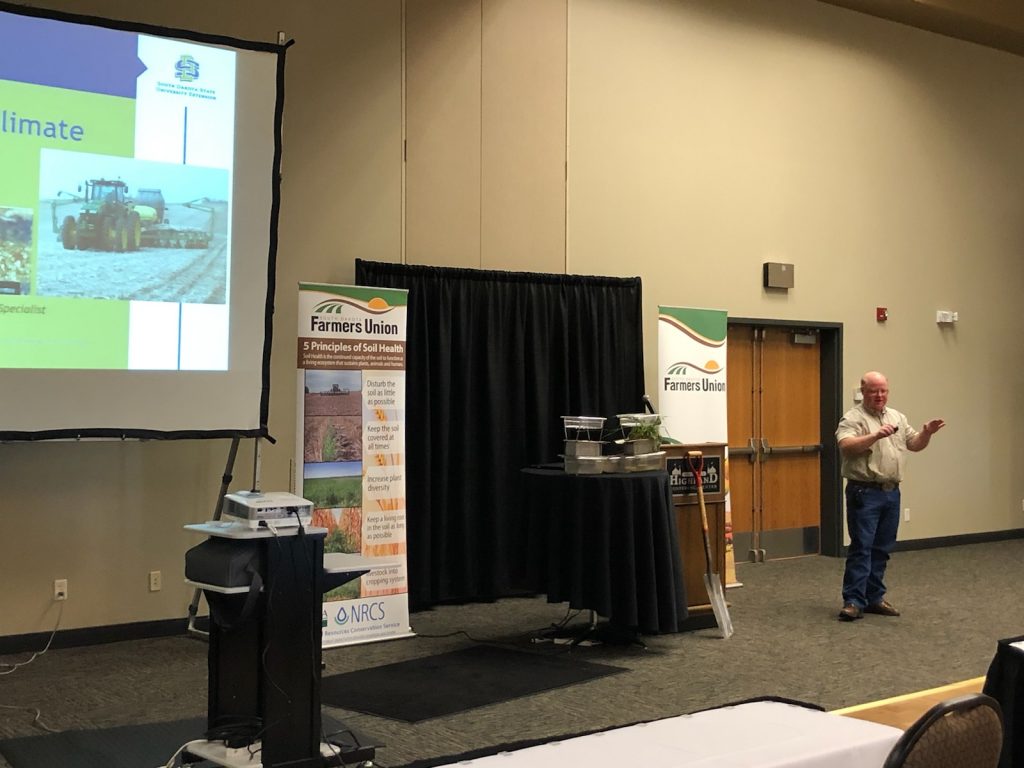Experts Share How Soil Health Can Reduce Impacts of Drought During Seminar
By Lura Roti for SDFU

Drought not only stresses crops and livestock, it also impacts their caregivers, explained Canistota farmer, Al Scott.
“There’s a lot of stress…and no rain days,” Scott said. “Expenses continue, but the income is likely to shrink. Right now, I’m debating whether to put more treatments on the crop – like fungicide, herbicide and insecticide – because of the cost.”
Scott was among the South Dakota farmers and ranchers to attend the Soil Health & Drought Management Workshop held in Mitchell July 27 and sponsored by South Dakota Farmers Union, South Dakota Soil Health Coalition, SDSU Extension and USDA Farm Service Agency.
Like most farmers, 2021 isn’t Scott’s first drought. The third-generation farmer says he’s learned from past droughts to keep a positive attitude. “We’ve got to stay optimistic to stay in this business.”

Scott points out each growing season is unique. Springfield farmer, Brad Odens agrees. “Here I’ve had ground in prevent plant the last few years because it’s been too wet to plant.”
This point was emphasized by seminar speakers SDSU Extension Climate Specialist and Meteorologist Laura Edwards and SDSU Extension Soils Specialist Anthony Bly.
“Look where we came from. We came from a deluge. No one knows what nature will throw our way and extremes are psychologically hard on us,” Bly said. “This is all about water management. Good soil health is your friend in either situation – too wet or too dry.”
Bly shared how fields managed with soil health practices like no-till, cover crops and diverse crop rotations, are more porous. Healthy soils are able to capture and hold water.
“Even in this drought year, we have places that got too much rain,” said Bly, sharing a photo of standing water in a Minnehaha County field after a storm dropped an inch and a half of rain in about 45 minutes. “What I don’t have a photo of is the dust blowing off the top of the hill the same day because it was so dry.”
Bly explained more porous, less compact soils allow plant roots to access water. And because residue from previous crops is left on fields managed with soil health practices, soil temperatures are lower – reducing plant stress and increase water intake.
He added that in extremely wet years, like 2019, some no-till fields with crop residue allowed some farmers to get necessary machinery into fields in a timely fashion to harvest crops.
“Soil health is about improving soil resiliency, so it is able to overcome adverse climate extremes,” Bly said.
He encouraged farmers and ranchers interested in building soil health to begin by learning about the five principles of soil health and begin implementing them. “You don’t get healthy soils overnight and you don’t change a system on a dime. This is why it is so important to start now,” Bly explains.
Patience is key, explained Wolsey farmer, Bill Chase. “This is long-term knowledge. It isn’t a fix now that we are in this drought.”
Chase and his wife, Kathy also raise livestock, so in addition to monitoring their crops, they also spend their days hauling water. The couple said they also appreciated the drought relief information provided by the Farm Service Agency representative.
Seminar speaker, Dan Forgey understands what it’s like to make field decisions today that will take time to yield results. Forgey has farmed near Gettysburg for more than 50 years and for the last 30 years he has focused farm management on soil health practices. He serves on the Board for the South Dakota Soil Health Coalition. In his talk, Forgey shared positive results he has seen after implementing each of the five soil health principles: soil cover, limited disturbance, living roots, diversity and integrating livestock.
Forgey’s presentation also included several lessons he’s learned as he worked to increase fields’ soil health. Thirty years later, soil tests show soil health practices have increased field organic matter from 2.8 percent to 4.1 percent.
“The water gain per acre for every percent of organic matter is about 25,000 gallons,” Forgey shared. “Soil health is my passion. I am old and I am about done. I have been fighting this battle for 30 years and that is why I came here today. If I can help one producer change his mind on what he is doing.”
Improving his fields’ soil health is the reason Dimock farmer Jason Tiede attended the seminar. “It’s for the future. Every time I am able to attend a soil health event, I learn something new or I am reminded of ways to improve the health and productivity of the land.”
To learn more about soil health, access information and resources or to connect with Soil Health Technicians, visit www.sdsoilhealthcoalition.org. To learn more about seminars and events South Dakota Farmers Union hosts for South Dakota’s family farmers and ranchers, visit their website at www.sdfu.org.

